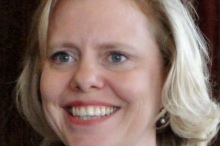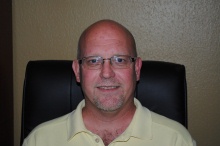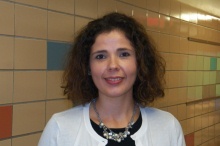Champions of Change Blog
Change the Shape of the Floor
Posted by on August 22, 2012 at 2:16 PM EDT Jessica Gogerty is being honored as a Champion of Change for her efforts in school turnaround.
Jessica Gogerty is being honored as a Champion of Change for her efforts in school turnaround.
Poverty can affect student achievement. For years, North High School in Des Moines, Iowa, had been a victim of its demographics: as poverty rates rose, our achievement rates fell. Among Iowa high schools, North has some of the highest percentages of students learning English, served in special education programs, and receiving free or reduced priced lunch. A complacent and woeful culture developed among the staff and students as our test preparation efforts yielded only plummeting scores. By 2010, my beloved North High, where I had taught Physics for 13 years, was the lowest scoring school in the state of Iowa. That desperate spring, North won a School Improvement Grant (SIG) and began the transformational model that required a complete restructure of school leadership.
Consider the culture of a school – the assumptions and beliefs that go unchallenged and universally accepted – to be like the low spot on the floor. When you pour the water onto the low spot, it is where the puddles form. While with effort the water can be pushed out of its puddles, when the external force is no longer applied, the water will re-puddle exactly as before. This is the most important lesson I’ve learned over the past two years as a SIG school: to have an order-of-magnitude lasting change to a school, you must not push the puddles around – you must change the shape of the floor.
North’s charismatic new principal was able to drive the conversations to solve the problem of low achieving students with the creation of School Improvement Leaders (SILs), or teacher leaders. We changed the master schedule twice in the first year, creating new classes, bell times and embedded times for staff collaboration and support. Changes were made in the attendance policy, discipline policy and the grading policy. The SILs taught the staff how to collect and analyze data on student performance and led discussions about strategies to address deficiencies. Teachers became empowered to help the students rise to their destiny instead of falling to their fate.
By the end of our first SIG year with over 99 percent of enrolled students tested, North students had gained 19 points in both reading and science and 11 points in mathematics on Iowa’s standardized test. The school had the same demographics and largely the same teaching staff. But now we had “One Vision, One Mission, One Destiny” as the instructional leadership harnessed the collaborative power of the adults in the school.
By design, SIG is a temporary infusion of resources. Government policy and programs can inspire and incentivize, but the people in the school must do the real work of cultural change. The SIG was an important catalyst for North. Without the additional manpower and resources, change at North would have happened much more slowly or not at all. It is easy to let tradition carry us—to allow our unchallenged belief in our capacity to determine what we will achieve—for good or ill. SIG gave us the impetus for the necessary introspection required to change the shape of the floor at North. We have begun the necessary transition to maintain this growth in student achievement and cultural change even after we graduate from the SIG program. Because North is changing its cultural floor, the benefits of SIG will continue long after the funding has ended.
Being recognized as a Champion of Change is humbling for me as an individual because while poverty matters in student achievement, it is the collaborative adult actions in the school that matter more. So, I can only accept this recognition on behalf of the North High team who worked so tirelessly. Thank you.
Jessica Gogerty is a National Board Certified teacher, a Presidential Awardee for Excellence in Math and Science Teaching, and a school improvement leader now serving at Roosevelt High School in Des Moines, Iowa.
Transforming Communities through Public Education
Posted by on August 22, 2012 at 2:06 PM EDT David Romick is being honored as a Champion of Change for his efforts in school turnaround.
David Romick is being honored as a Champion of Change for his efforts in school turnaround.
Public education is one of the most fundamental rights of American citizens. As a career public educator, I have long advocated, both behind the scenes, and right out front, for public school teachers so that we can give our students the world-class education they deserve. As a product of the Princeton City Schools in Cincinnati, Ohio, I realized early that the foundation I was given enabled me, with hard work and commitment, to succeed at the undergraduate and graduate levels at several of the area’s finest universities. My grandmother was a teacher in Lakewood, Ohio. Both of my parents as well as subsequent step-parents were also professional educators in Ohio’s public school system. Yes, I had a choice about what direction to take with my life, but I chose one which has provided me and my family with many years of deep satisfaction and purpose.
Public education is the avenue for transforming communities. Early in my career, I chose to meet the challenges of public service in an urban environment – the Dayton Public Schools, in Dayton, OH. Unlike many cities, Dayton does not have pockets of wealth, so we are particularly hard hit by the current recession. There is, however, rather a deep sense of community pride which must be built upon through education. This is absolutely crucial to the growth of our city.
So what can a teacher do to affect change in his or her community? I was encouraged by colleagues to step into various leadership roles, beginning at the building level and continuing until my present position as president of the Dayton Education Association. In this position, I have been able to have a hand in affecting necessary change in our school district while advocating for public education and public school teachers at the local, state, and national levels. Change and advocating for change are both difficult, but through the work of the Ohio Education Association (OEA) and the National Education Association (NEA), I have been given the resources and assistance necessary to continue the work in which I believe so deeply.
As an example, Dayton’s Belmont High School was in a similar situation as Eastside High, documented in the movie Lean on Me, which profiles what we have come to know as a school turnaround. Through collaboration with the building and district administration, school staff, and with resources from both OEA and NEA, the Priority Schools Campaign in particular, Belmont’s school community was able to build an educational institution where there once was an out of control, dangerous, low-achieving building. This transformation has proven to the local community, and the greater Dayton community that change can happen – when people work together, instead of in opposition, great things can happen for the children we serve and the communities in which we all live.
David Romick is currently serving his first two-year term as the president of the Dayton Education Association, the Ohio Education Association affiliate in Dayton, Ohio.
Fostering a School and Home Connection
Posted by on August 22, 2012 at 1:48 PM EDT Lucia Requenes is being honored as a Champion of Change for her efforts in school turnaround.
Lucia Requenes is being honored as a Champion of Change for her efforts in school turnaround.
It is an honor to be recognized as a White House Champion of Change. My journey began in the summer of 2010 when I received a letter informing me of the restructuring of Emerson Elementary School as a result of low performance in student achievement. As an involved parent, this came as a shock. Although I had been participating in the school PTA, I was surprisingly uninformed. I was left asking myself, “What can I do?”
After a lot of thought, I took the opportunity to apply for a Community & Family Specialist position at Emerson Elementary. By that time, I think the principal knew that if I was not hired, I was going to be at the school anyway. After being offered the position, I began to look for parent involvement information and supports for our school. One of my first steps was to set up a meeting with the Kansas Parent Information Resource Center (KPIRC) to discuss our approach to involving families. In order to prepare teachers to engage families, KPIRC and I collaborated to provide professional development to all faculty members at Emerson on engaging families in their children’s education. During this training, teachers identified strategies and created a “classroom plan of action” that they would use during the current school year to engage families in alignment with the PTA National Family School Partnership Standards.
After collaborating with others, I decided to foster the most important component of the process – the school/home connection. I knew that if we were ever going to improve at Emerson, we would need to reach out to parents in a genuine and respectful manner. This meant doing over 130 porch visits with our families to introduce myself, welcome families, and let them know we are partners in their children’s education. This year our porch visits expanded to include all of Emerson’s staff.
Currently, our Parent/Community Outreach Program has grown to include a reading component in which families directly participate in helping their children in school. Additionally, we are able to facilitate the opportunity for families to enroll in English classes. Another program in place is the 5th Grade Leadership Group in collaboration with the Kansas City, Kansas Police Department, which focuses on social issues and provides a positive experience that explores leadership and careers.
We all know that learning starts at home, and by engaging families in their children’s learning, we can influence a child’s achievement. I’m proud to be a small part, in building the community that can surround our children with the love and encouragement needed to lead them down the road to success and happiness.
Lucia Requenes is a community and family specialist for Emerson Elementary.
Realizing Student Potential
Posted by on August 22, 2012 at 1:38 PM EDT Carren Poff is being honored as a Champion of Change for her efforts in school turnaround.
Carren Poff is being honored as a Champion of Change for her efforts in school turnaround.
I am honored and humbled to be a White House Champion of Change on behalf of Ontario High School (OHS) in Ontario, Oregon. Growing up, loving and supportive family members encouraged education, service, and a good work ethic. They taught me to push myself, to try new things, and to set and achieve goals. It was their examples that helped me develop a deep love of learning, serving others, and finding worth in everyone. Those influences have shaped who I am today: a young teacher with an unquenchable desire for every student to feel a sense of worth and to feel confident about abilities and options in life. I want them to realize their potential.
The students of Ontario School District are faced with significant challenges that influence self-confidence, ability to focus, and ability to stay in school until graduation. Our county is the poorest in the state of Oregon. With high migrant and English language learner populations, many do not have adequate resources outside of the classroom and have little to no support from families due to the lack of higher education; students are pressured to drop out of school to provide for basic family needs. As nationwide budget cuts reduce school and district resources, the roles of individual teachers become more vital. Our students are bright, caring, and talented—we, as teachers, have the monumental task of helping them pull away defensive masks so they can seize educational opportunities.
I have been blessed with many opportunities to learn and grow as a teacher. One of the top priorities of our English department is to raise expectations and achievement levels for each student—ensuring readiness upon entering the global economy. We strive to challenge them and let them know we are confident they can achieve. To help scaffold our high expectations, we completed several integral tasks. We redesigned the English 9-12 proficiency-based curriculum founded on the nationwide common core standards. We aided in the creation and teaching of Freshman Success—a newly implemented course designed to teach organizational and foundational skills to help freshmen stay on-track for graduation, as well as to introduce them to a variety of college and career opportunities. Additionally, we initiated and taught the Language! curriculum—a reading and writing intervention that explicitly teaches the building blocks of the English language, while simultaneously aiding in building student academic success and confidence. We created a senior reading and writing intervention course to help meet the Oregon diploma requirements, and redesigned the honors and college credit English programs to ensure college-level work, and to help students be more competitive and prepared for higher educational opportunities.
The results from these curriculum changes, interventions, and programs have not only been evidenced by increases of 10 to 20 percentage points in state assessment scores while significantly closing achievement gaps, but students have begun to believe in themselves. One student in my senior reading course, after learning and applying the appropriate reading strategies, was able to pass her state test. She became overwhelmed with emotion and told me she never believed she had the ability to pass. A college education was an unachievable dream for her, but she is currently enrolled in fall term at Treasure Valley Community College. I will continue to work alongside administration, OHS colleagues, and fellow department members to ensure each student discovers and unleashes personal potential.
Carren Poff is the English Department chair for Ontario High School.
A Holistic Perspective
Posted by on August 22, 2012 at 1:24 PM EDT Kristen Hayes is being honored as a Champion of Change for her efforts in school turnaround.
Kristen Hayes is being honored as a Champion of Change for her efforts in school turnaround.
The primary motivation behind my artmaking has always been to affect the viewer in some manner: to facilitate the occurrence of a “holistic” experience, allowing participants to walk away with a broader sense of the physiological impact of all art forms. When you are completely surrounded by a visual stimulant, you are undeniably affected in some way.
As a result of working within the D.C. Public Schools system as an art educator, I have witnessed the benefits of educating the “whole” child, where the elements of art, particularly color, are integrated as tools for higher learning. “Color Is Life” is one approach to connecting the arts to the development of the whole child.
Several studies have proven the emotional, mental, and physical influences that bold colors have on academic environments. These settings are immediately transformed into places that are emotive in nature, facilitating a higher educational experience. Because colors feel innately “good”—the energy is positive and welcoming and the students are made to feel happier – it becomes easier and more enjoyable for students to focus and comprehend. Strategically planned color schemes have been proven to facilitate improvements in test scores, reducing absenteeism for students and faculty and increasing unity among peers. Color celebrates diversity and promotes a greater sense of security for students.
Unfortunately, you will typically find public school walls in urban areas filled with dull and very muted color paint, exhibiting more of an institutional feel, rather than one of excitement and invitation. As the majority of these students’ time is being spent at school, it is crucial that they are surrounded not only by positive people, but an uplifting environment as well.
I am fortunate enough to have found a principal, Mr. Patrick Pope of A. Kriger Savoy Elementary School, who was more than willing to adopt my endeavor, “Color Is Life,” and incorporate the concept of color transformation into his school. Savoy is located in the southeast neighborhood of Anacostia, an area in which you will find beautiful landscapes and a rich history of African and Native American culture. Through “Color Is Life,” Savoy students have explored the more functional role that color plays in different cultures, in addition to being given an opportunity to better understand the critical thinking process of color theory and analyzing how pairings of certain colors create an area that is pleasing to the senses. The goals of the initiative are not only to provide under-served spaces with stimulating color combinations that enhance learning, but also to educate the students and faculty on the therapeutic power of color transformation, the cultural relevance of the colors being used (with the addition of Native-American and African textile-inspired murals on the walls), and the value of creative thinking.
Currently, “Color Is Life” has also expanded to another southeast public school, Ballou Senior High School, where the aspiration is to lift the spirits and morale of all who enter the school and to be a catalyst for higher achievement for the students this coming school year. With this particular endeavor, we have collaborated with other community entities, including “Guerrilla Arts” and “Slickfish,” both of whom continue to foster arts-integrated programming for the youth of the D.C. area.
As a native Washingtonian and as an artist, I am certainly proud to be serving my community in this way. I will continue to work to extend my art through “Color Is Life,” being excited for those administrators and others who are receptive to the significance of color transformation in all social environments. For the sake of urban students’ future, officials of school systems should begin to exhaust every resource that will aid in the encouragement and ultimate success of our children’s education, particularly those already living in under-served communities. Color is truly a vehicle that can and has made a difference in the lives and academic achievements of the city’s students.
Kristen Hayes is an art instructor for the District of Columbia's Public School system.
Providing for All Students
Posted by on August 22, 2012 at 1:18 PM EDT Dr. Tanya R. Green is being honored as a Champion of Change for her efforts in school turnaround.
Dr. Tanya R. Green is being honored as a Champion of Change for her efforts in school turnaround.
When I was appointed the principal of Calverton Elementary-Middle School, the school was one of the lowest performing in Baltimore City and on the state’s persistently dangerous list. I immediately recognized that in order to move the school forward, I would need to not only engage the students, but their families. After selecting a strong leadership team that shared a common vision, we worked to provide wraparound services to students and families. A food bank was instituted at the school, an at-risk student program was developed, after school programs were created to meet student needs and interests, and partnerships with mental health programs were established to support students and their families. After my first year, the school had been removed from the state’s persistently dangerous list and some academic growth was made, but we still had a long way to go to meet our goals.
Due to years of low academic performance, the school was designated a turnaround school. Baltimore City selected Friendship Public Charter Schools, an organization with a track record of success in both Washington D.C. and Baltimore, to serve as a Lead Partner and operate the school under the new name: Friendship Preparatory Academy at Calverton. From the start, Friendship’s approach was one of true partnership. Chris Maher, Friendship’s deputy chief academic officer, worked with me to make decisions, including hiring teachers, creating a budget, and aligning our programs and partners to school performance goals. We collaborated to create and deliver job-embedded professional development that reflected my teachers’ needs. We worked together to develop parent workshops to help parents understand their student’s data and to learn teaching methods to assist students at home. Friendship invested in my leadership team by sending us to summer sessions at Harvard University.
This partnership model of turnaround was evident to everyone who came in to evaluate our progress, including the district, state, the U.S. Department of Education, and independent evaluators. Baltimore City, Friendship, and Calverton’s school-based leadership work collectively toward one goal: providing all students with a world class education. As a result of this hard work and partnership, Friendship Preparatory Academy at Calverton met all of the state targets for reading, mathematics, and attendance in 2012. The school was also the recipient of the Race to the Top STAR (Strategies Targeting Achievement and Retention) Award, an incentive award for improving school climate outcomes.
While quite a feat for a school that was not long ago designated one of the state’s most dangerous and lowest performing, I am most proud that the accomplishments were made without changing the student demographics and population. The school still has a special education population that exceeds 30 percent, including a program for students with emotional disturbance and students with autism. The school has over 90 percent of its students receiving free and/or reduced meals. In addition, the school continues to accept all students regardless of high-risk behaviors or academic performance.
True turnaround leaders should be able to make the necessary changes and establish meaningful programs that support all students, especially those that have the highest needs. We have accomplished that, and I am honored to be an agent of change at Friendship Preparatory Academy at Calverton.
Dr. Tanya Green, Ed.D is the principal of Friendship Preparatory Academy at Calverton, a turnaround school within the Baltimore City Public School System.
- &lsaquo previous
- …
- 94
- 95
- 96
- 97
- 98
- 99
- 100
- 101
- 102
- …
- next &rsaquo

